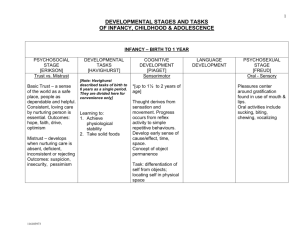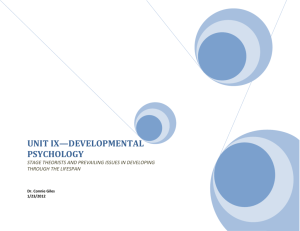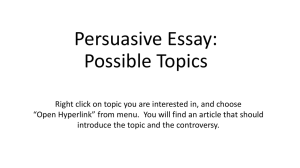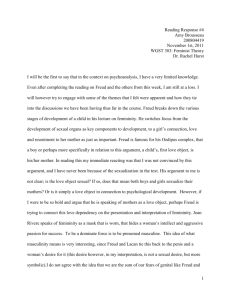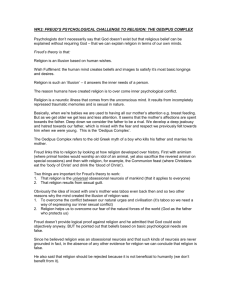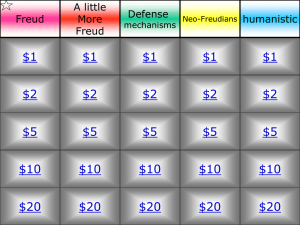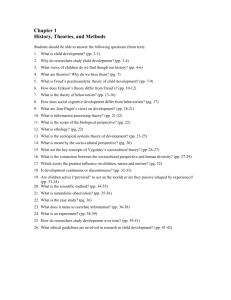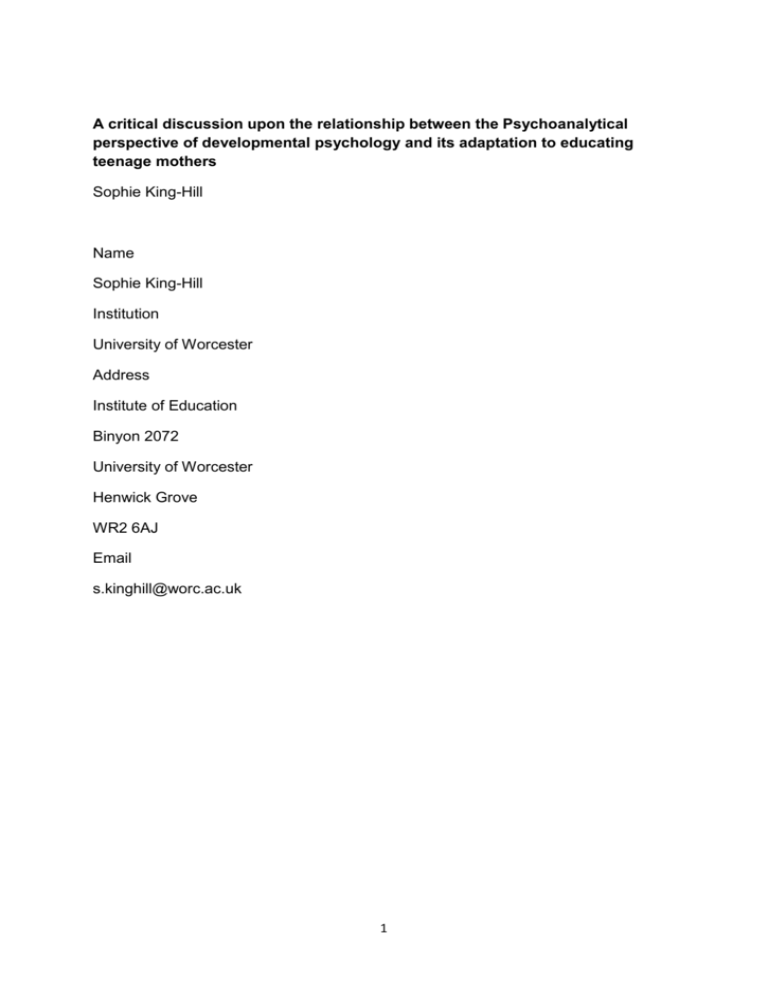
A critical discussion upon the relationship between the Psychoanalytical
perspective of developmental psychology and its adaptation to educating
teenage mothers
Sophie King-Hill
Name
Sophie King-Hill
Institution
University of Worcester
Address
Institute of Education
Binyon 2072
University of Worcester
Henwick Grove
WR2 6AJ
Email
s.kinghill@worc.ac.uk
1
A critical discussion upon the relationship between the Psychoanalytical
paradigm of developmental psychology and its adaptation to educating
teenage mothers
This paper will critically explore elements of the psychoanalytic paradigm of
developmental psychology in relation to the professional practice of working with
teenage mothers in an educational setting.
Particular focus will be given to the psychosexual and psychosocial staged theories
of development. The framework for this critical analysis will examine each stage of
psychosexual and psychosocial theory in relation to teenage motherhood. These
perspectives have been specifically chosen due to the explicit links between staged
childhood experience and adult behaviour in relation to sexual and social aspects of
development, both aspects having fundamental links to teenage parenthood.
Four case study examples are used to demonstrate how psychoanalytical theory
may relate to this cohort. These are taken from the author’s past professional work
as a teenage parent programme lead. The examples are given to shed light on the
impact of each psychosocial and psychosexual stage of development.
This article concludes that whilst both the psychosocial and psychosexual models of
development are useful in giving educators a perspective into behaviours that are
displayed in adolescence, they are but one of many perspectives that should be
taken into account when working with this cohort.
Keywords
Teenage pregnancy; teenage parents; Freud; Erikson; risky sexual behaviour,
psychosocial, psychosexual
2
Introduction
This paper will discuss the psychosexual and psychosocial theories of development
as a viewpoint when working with teenage mothers. Whilst the author acknowledges
that the theories have some flaws, it is hoped that this paper demonstrates that
behaviour and its manifestations may have many influencing factors. This paper
hopes to demonstrate to educators that work with this cohort in an educational
setting is complex and many avenues, perspectives and approaches need to be
considered.
Many theories within developmental psychology are centred around the debate of
whether development is innate or is determined by outside factors (Woolfe, 1998).
This was influenced, according to Gianoutsos (2006) and Morris (1996), by the work
of 18th century philosophers Locke and Rousseau. Locke asserted that a child was a
‘blank slate’ in which development is influenced by environment. In opposition to this,
Rousseau proposed that a child is born ‘inherently good’ with pre-determined stages
of development. It is this basis which formed the ‘nature versus nurture’ debate.
This debate can be linked directly to the professional practice of working with
teenage parents (DeJong, 2003; Dean, Ducey and Malik, 1998; Andrews and
Brewin, 2000). Teenage sexuality from a ‘nature’ perspective recognises that sexual
urges to reproduce at this stage in development are a natural part of human
progression (Phoenix,1991; Arai, 2009; Moore and Rosenthal, 1993). From a
‘nurture’ perspective, teenage sexuality and reproduction is viewed as nurture based,
and in view of the psychoanalytic paradigm, closely related to childhood experiences
(Freud, 1905; Erikson, 1963 and 1993 ).
Freud is acknowledged as the founder of psychoanalytic theory. In the late 19th
century Freud proposed the concept of psychosexual development, based upon
staged development from childhood to adulthood. Successful completion, Freud
asserted, is dependent upon the correct amount of gratification given at each stage.
If over, or under, stimulation is received at one of the stages then ‘fixations’ upon the
stage can occur and become repressed in the unconscious, becoming apparent in
behaviours displayed in later years. Linking into psychosexual development, Freud
also proposed the division of the human psyche into three components: the Id, the
ego and the super ego. It is the ego that restrains the Id’s urges, by satisfying primal
impulses by socially acceptable means. The super-ego operates as the moral and
ethical component of the psyche and is often referred to as the ‘conscience’,
regulating the ego via feelings of guilt and moral awareness (Freud, 1905; Garcia,
1995). Freud also introduced the concept of transference, where the influences and
experiences of childhood, and the feelings they created, are unconsciously
redirected and ‘projected’ upon individuals in later years. Kapelovitz describes
transference as:
‘The inappropriate repetition in the present of a relationship that was
important in person's childhood.’
(1987, p.66)
3
Reality is distorted in transference by the unconscious which is influenced by past
experiences and future aspirations (Plaut, 2005; Jung, 1981). Despite their
widespread influence, Freud’s theories have come under much criticism.
Freud’s theoretical work was based upon limited case studies, dependent upon the
interpretations of both Freud and his patients. Criticisms of his generalisations to a
universal theory, based upon this double hermeneutic, raise validity concerns
(Eysenck, 2004). Freud’s methodologies appear to lack scientific and empirical
rigour and positivistic nature which is required to make generalisations. Eysenck
highlights this stating that: ‘…‘the points [Freud] makes must be judged in terms of
their factual relevance and logical consistency’(Eysenck, 2004, p.12).
Freudian theory also appears to be based upon Victorian gender ideologies that
were apparent at the time of his writings, Slipp reflects this view stating:
‘Freud’s views on female psychology were erroneous because
they…reflected and perpetuated the Victorian bias against women’
(Slipp, 1993, p.1).
It is this apparent gender bias that has called Freud’s theories into question when
adapting them to contemporary culture. Many of Freud’s concepts were based
around the individual and how they are influenced in relation to gender and sexuality
and did not acknowledge social influences on development.
Erikson built upon Freud’s theory by introducing a social element to the ideas in
psychosexual theory by means of an eight stage psychosocial Model (Erikson, 1963
and 1993). Psychosocial development has conflicts in each stage that need to be
completed with balance, in chronological order, for individuals to reach full
developmental potential. Erikson discusses the need for balance within each stage
stating:
"...What the child acquires at a given stage is a certain ratio between the
positive and negative, which if the balance is toward the positive, will help him
to meet later crises with a better chance for unimpaired total development..."
(1993 p.61)
Despite adding the social element to developmental theory the Psychosocial theory
does come under criticism. Much of Erikson’s work was based around males,
therefore the application of the psychosocial theory to females as a generalisation to
both genders appears to question validity (Friedan, 1963; Greer, 1970).
Psychosocial theory incorporates perspectives from morality, philosophy and ethics,
which are by nature subjective and ambiguous, making it adverse to rigorous testing
and empirical measurement (Boa, 2004). It can also be argued that staged theories
of this nature are too prescriptive, not acknowledging cultural and social variations
(Curtis and Pettigrew, 2009).
Both the psychosexual and psychosocial theories incorporate the importance of
adolescence, linking to experiences that teenage parents have around sexuality and
4
identity. It is important, when viewing both theories in this context, to recognise the
impact that the previous stages of development have upon teenage parenthood.
Research in the area
This section will examine research in the area of teenage parents and education and
critically discuss some of the findings in relation to working with teenage parents in
an educational setting. An individualistic approach to the adolescent parent’s needs,
taking into account differentiation and the additional needs of parenthood, may help
form positive teacher / student relationships. Knowledge of ‘transference’ and also
‘counter transference’, when past experiences of a teacher may impact upon the
relationship, is also useful when examining differentiated learning and approaches,
using reflection to examine projective behaviours (Jung, 1981; Curtis and Pettigrew,
2009). By positive achievement and raised feelings of self-worth a young parent may
also gain raised aspiration for the future. Various research studies have shown that
young parents view parenthood as a means to progress, rather than as an inhibitor,
viewing education as a way to achieve progression (see Duncan, Edwards and
Alldred, 2008; Duncan, 2007; Macvarish and Billings, 2008).
Macvarish and Billings (2008) conducted a qualitative study where the complex
behaviours of thirty five teenage parents were examined through in-depth interviews,
positive regard for education was found to have emerged as a direct link from
parenthood. Part of The Millennium Cohort study (Hawkes, 2008) used the
quantitative data of 2831 teenage parents to examine the impact of parenthood in
adolescence. The study found that many of the young parents came from
disadvantaged backgrounds, with pregnancy having no major impact upon the
disadvantage already experienced (Hawkes, 2008). The study concludes that
teenage parenthood alone is not a direct indicator for poor outcomes, it is social
inequality and lack of opportunity which are the influencing factors in negative
outcomes for adolescents (Hawkes, 2008).
A study from the Institute for Fiscal Studies found that negative life chances, as a
direct result of teenage parenthood, are relatively small in relation to other factors
such as socio-economic status (Daguerre, 2006). The Baltimore Study (1972), cited
in Schofield (1994), was a longitudinal study carried out over 17 years, that found
many teenage mothers ‘stage a recovery’ after pregnancy, with the only differences
in educational and financial outcomes being sequential in life events and a renewed
positivity towards employment and education.
Links to teenage parenthood
This paper will now go on to discuss how the psychosocial and psychosexual
theories may give one of many perspectives of teenage parents and their behaviours
(summarised in table 1). Case study examples, from my previous professional
practice will be used to illustrate the points made.
The first stage of the psychosocial theory occurs from 0-1 years where ‘trust vs.
mistrust’ are in conflict. These are linked to social experiences and relationships with
the main caregiver. If a balance is not achieved through lack of nurture this may
manifest itself in teenage years (DeJong, 2003; Young, Deardorff, Ozer, and Lahiff,
5
2011). The first stage in psychosexual development also occurs at this point,
referred to as the oral stage, where pleasure and trust is gained from sucking. This is
linked to the ‘Id’, which is inherent from birth, operating upon the ‘pleasure principle’
and is based around the immediate pleasure and gratification of impulsive drives
(Freud, 1905; Garcia, 1995).
If balance is unsuccessful then ‘mistrust’ can occur, manifesting in over dependant or
aggressive behaviours in adolescence which are related to transference of ‘mistrust’
upon others. Individuals may be wary of others intentions and project a lack of trust
for peers, partners and support workers. (DeJong, 2003; Andrews and Brewin,
2000). In the professional context of working with teenage parents mistrust,
aggression and dependency may manifest itself within the parents’ relationships with
their children creating a perpetual cycle (DeJong, 2003; Dean et al, 1998). As an
illustration of this I present Cases study 1, a young woman with whom I worked for a
number of months in an educational setting:
Case study 1
Student ‘A’, a fifteen year old female with a child aged six months, displayed
aggression towards support workers, over dependence upon her partner and a lack
of attention to her child. ‘A’ was in the care system from age six months due to
parental neglect.
When taking the psychosocial and psychosexual perspectives ‘A’s’ behaviours may
be linked to a lack of balance achieved at the first stage in psychosocial
development, and due to neglect between 0-1 years old ‘trust’ and ‘pleasure’ was not
gained from the nature of the feeding relationship, manifesting in behaviours in later
years.
Viewing teenage parents from this psychoanalytical perspective alone can be too
focused upon the impacts that oral gratification and nurture, in this timeframe, has
upon teenage parents and their offspring. Appearing dismissive of other factors such
as cognitive development and eco-systemic influences of the succeeding years
(Moore and Rosenthal, 1993; Curtis and Pettigrew, 2009; Freud, 1905).
The second stage of Erikson’s model refers to ‘autonomy versus shame’, occurring
in early childhood, and is linked to social reactions to events in which the individual
has an element of control. To gain balance, independence needs to be nurtured by
the caregiver. This stage links to the anal stage, the second in the psychosexual
model, where the focus is upon the control of bowel movements and the sense of
independence gained from this (Freud, 1905). If bowel movements are not managed
by the caregiver adequately this can impact upon personality in succeeding years.
Negative traits may become transferred to adolescent relationships, projected via
risky sexual behaviours (Dejong, 2003; Erikson, 1963 and 1993). ‘Shame’ may
become apparent in adolescents’ parenting styles, manifesting in a lack of adequate
responsibility and erratic, defensive and over-zealous opinions about parenting
(DeJong, 2003). Destructive or obsessive behaviours relating to risky sexual
behaviour may be apparent as a direct link from a lack of balance (Adams, Slater
and Muir, 2000; Andrews and Brewin, 2000). These behaviours may also be
6
exaggerated by the Id’s impulsive behaviours resulting in destructive behaviour due
to the under development of the ego (Boa, 2004; Garcia, 1995).
Parents displaying domineering personalities may influence this stage, resulting in
feelings of ‘shame’ (DeJong, 2003). Case study 2 illustrates how this may impact
upon behaviour, again, this was a student of mine in an educational setting:
Case study 2
Student ‘B’, a sixteen year old female with a one year old child, had many sexual
partners making it difficult to identify the child’s biological father. This display of a
lack of self-discipline and risky sexual behaviours may have stemmed from ‘B’s’ own
authoritarian parents. ‘B’ had strict parents and was not praised for achievements,
influencing this stage of development within the psychosocial and psychosexual
models. ‘B’ appeared to lack self-esteem and adaptability which are useful to
successful parenting. ‘B’ was excluded from school aged 14.
It may be suggested, in B’s case, that from a psychoanalytical perspective this may
be linked to the under development of the ego, displaying the impulsivity of the ‘Id’
(Freud, 1905).
Dean (1998) discusses the influence that parenting can have upon the identity of the
adolescent, stating that caregiver-child relationships act as templates for
interpretations of the world. For teenage parents these influences may impact upon
parenting styles, with the adolescent displaying the same behaviours to their
offspring as their parents did to them. Whilst it is apparent that parenting styles may
influence how children eventually parent, this is not prescriptive, and varies
dependent upon outside influences and the resilience and emotional intelligence of
an individual (Goleman, 1996; Lewis, 1999; Garcia, 1995; Hoffman and Maynard,
2008).
In pre-school years, the third stage of psychosocial theory, ‘initiative versus guilt’ are
in conflict. It is at this developmental point where a caregiver should encourage and
support a child to explore their environment and balance is achieved through feelings
of accomplishment (DeJong, 2003). If balance is not achieved, impacts of this may
manifest themselves in adolescence as unmotivated behaviours towards education
and passivity in risky sexual relationships (Erikson, 1963 and 1993; Arai, 2009).
Teenage parent behaviours as a result of ‘guilt’ may be apparent in a lack of future
planning, empathy, motivation and insensitivity to the needs of a baby (Dean et al,
1998).
This stage also relates to the third stage in psychosexual development, the phallic
stage. Within the phallic stage the oedipus complex emerges, with males fearing
emasculation by their father as a result of desire for their mother. The feminine
oedipal attitude also emerges with females assuming castration by their mother as a
result of desire for their father. This results in both sexes identifying with the same
sex parent and adopting their values and actions, in an effort to gain their
acceptance, influencing the development of the super-ego (Freud, 1905; Garcia,
1995; Dean et al, 1998). If an adequate relationship with the same sex parent is not
achieved this can impact upon transference behaviours displayed in adolescence,
projecting past fears of rejection upon relationships possibly resulting in risky sexual
behaviour (Freud, 1905; Garcia, 1995).
7
Many feminist critiques of the phallic stage have been made since its introduction,
Horney (1994) challenged Freud’s views that these were representative of women’s
envy of male dominated society rather than acceptance of castration. Within feminist
critique Freud’s ideas were seen to be representative of misogynistic repression,
creating images of the passivity and inadequacy of women (Friedan, 1963; Greer,
1970; Slipp, 1993).
Robinson reflects this view stating:
‘The theory condemned women to perpetual inferiority (because “anatomy is
destiny”), representing them as castrated males whose lives were dominated
by efforts to compensate for this fundamental defect’.
(1993, p.13)
Criticisms of the psychosexual theory also incorporate the positivistic nature of
research that precedes generalisations. Horney (1994) questioned Freud’s
methodology stating his premise was based upon the recall of ‘neurotic’ patients
rather than controlled empirical research. This lack of empirical rigour appears
subjective and prescriptive, when considering risky sexual behaviour and pregnancy
in adolescence. This view would make no acknowledgement of the eco-systemic and
contextual influences that also impact upon early sexual debut (Eysenck, 2004;
Dean , 1998; Andrews and Brewin, 2000).
In the fourth stage of psychosocial theory ‘industry vs. inferiority’ are in conflict. This
takes place within the school years and can be related to self-perception in
comparison to peers (Erikson, 1963 and 1993). Failure to achieve the same status
and outcomes of peers can cause imbalance, resulting in low self-esteem and poor
self-concept (DeJong, 2003). Many factors depend upon peer rejection and
acceptance, which are based within social, emotional and cultural norms (Curtis and
Pettigrew, 2009; Adams et al, 2000). If these factors do not fit within the majority
then peer rejection might ensue, resulting in feelings of ‘inferiority’ becoming
dominant (Freud, 1905; Dean et al, 1998).
Within psychosexual development this stage links directly to the ‘latent stage’, in
which sexually related motivations lie dormant due to the need to fit, and adjust, to
societal norms, reinforcing the importance of identifying with peers (Freud, 1905;
Garcia, 1995). If ‘industry’ is not achieved within ‘latency’ then this can generate
feelings of incompetence and hopelessness within adolescence. This may result in a
desire for self-worth potentially manifesting itself in pregnancy and parenthood
(Musick, 1993). Case study 3, a young woman who I worked for a number of
months, below illustrates how this stage may relate to behaviour:
Case study 3
Student ‘C’ was raped at 13, and as a result was disbelieved and rejected by peers,
as this occurred within the latency, ‘industry vs. inferiority’ stages, when acceptance
by peers is crucial to psychological development, a negative impact on self-esteem
and self-image ensued. ‘C’ went on to have 3 children by age 18.
Within the psychosexual and psychosocial models, it may be supposed that ‘C’
gained bodily worth and psychological inclusion from pregnancy. ‘C’s situation
8
cannot be assessed by stage development alone and account needs to be taken of
the impacts that rape and subsequent sexual behaviour has within individual and
cultural contexts. Poor self-concept at this stage may not only be related to peers in
this bracketed age group but to historical, eco-systemic influences, taking into
account individual emotional intelligence and resilience that form perceptions of self
(Ashley, Jackson, Davies, 2008; Boyer and Fine, 1992; Berenson, San Miguel,
Wilkinson, 1992; Boyer and Fine, 1992; Roosa, Tein, Reinholtz, and Angelini; 1997;
DeJong, 2003)
The fifth stage in Erikson’s developmental model, ‘identity vs. role confusion’, occurs
between 12-20 years old and relates to the emergence and examination of self and
personal identity in relation to experiences in the earlier stages. If negative outcomes
occurred in previous stages ‘Identity’ could be compromised (Erikson, 1963 and
1993). The genital Stage of the psychosexual model also begins in adolescence,
with individuals developing sexuality and seeking out sexual partners. Garcia refers
to the Genital Stage as a:
‘…self-directed synthesis of the creative sexual instincts into meaningful, selfenhancing, and societally contributing adult life endeavours ‘
(1998, p.500)
If positive identity, through successful completion of the previous stage, is not
achieved then relationships in the Genital Stage may become detrimental to the
individual, resulting in risky sexual behaviours (Dean et al, 1998).
A quantitative study conducted by Musick (1993), found profound differences in the
outlooks of teenage parents whose experiences in the previous stages of
psychosocial and psychosexual development had negative outcomes. Musick’s
study found that adolescents who had positive outcomes were, at this stage, focused
upon future prospects within employment and education. Adolescents who had
negative experiences, were questioning identity and searching for the means to raise
their self-esteem and self-worth (Levison, 1986). Parenthood is often seen as the
answer, meeting the need for worth and identity consciously and unconsciously, with
risky sexual behaviours as a result of the negative staged outcomes prior to
adolescence (Dean et al, 1998). The effect of this upon parenting in adolescence
can be detrimental to both the adolescent and their child, as the adolescent may
focus upon rectifying the negatives of past stages whilst the socialisation of
adolescence is neglected (DeJong, 2003).
The genital stage is one that continues into adulthood and is resultant from
experiences at the preceding stages. Anna Freud (1936) when discussing
adolescence, refers to this period in development as an important element in
personality formation, with a focus upon the Id, super-ego and ego Solnit, 1997).
Freud (1936) states that adolescence is a time when the libido is triggered by the
sexual physiological changes. These disturb the psychological balance of the latent
stage resulting in inner conflicts between the Id, ego and super-ego when attempting
to regain the balance of latency (Muuss, 1975). An example of this stage may be
perceived in Case study 4, a young woman with whom I worked sporadically over a
number of years:
9
Case study 4
Student ‘D’, a seventeen year old female with two children, consciously planned her
children and had many sexual partners. Student ‘D’ had an erratic upbringing and
throughout all of the previous stages and it may appear that balance was not
achieved.
In the case of student ‘D’, from the psychosocial and psychosexual perspectives, it
can be supposed, that the impulsivity of the Id may have over-ridden the constraints
of the ego resulting in risky sexual behaviour driven by instinctive, primal urges,
rather than socially acceptable behaviours. This ‘over-ride’ may be as a result of
improper progress through the previous stages of the psychosexual model with
stunted development of the super-ego within the latent stage. This lack of progress
may result from trust in the Id’s impulses and the lack of ability to grasp abstract
ideas and concepts, instead focusing upon concrete libidinal urges (Solnit, 1997;
Midgley, 2012; Freud, 1905).
Jung (1981) disputed the existence of a purely biological unconscious, theorising
that the human psyche is made up of components, from a variation of sources,
incorporating the ‘collective consciousness’ of societal norms and morality (Jung,
1981). Foucault also rejected the supposition of unconscious drives:
“It is a matter of pointing out on what kinds of assumptions, what kinds of
familiar, unchallenged, unconsidered modes of thought the practices that we
accept rest."
(1988, p.155)
Foucault’s referral to the assumptions made were in concern for individuals that
differ from the expected developmental norms and the cultural ideologies that the
unconscious drives were based (Whitebook, 1999). In the case of teenage parents
this would be evident in the assumptions that pregnancy in adolescence results from
concrete libidinal drives, and the lack of abstract reason; implying developmental
problems within prescribed stages, putting the ‘problem’ firmly within the individual
due to their past experiences, neglecting other influences impacting upon societal
perceptions of pregnancy in adolescence (Travell, 1999; Smith, 2006; Whitebook,
1999).
Whilst the final stage in the psychosexual model begins at adolescence,
psychosocial development has three further stages; ‘intimacy vs. isolation’,
‘generativity vs. stagnation’ and ‘ego Integrity vs. Despair’. The support a teacher
can give for the next stage of ‘intimacy vs. isolation’, which relates to ages 20-24 and
examines individual relationships, can impact positively on the outcome of this stage,
possibly combating the inferiority experienced through education in the fourth stage
of development (DeJong, 2003; Young et al, 2011).
A teacher displaying respect, consistency, sensitivity and acceptance in their
approach to teenage parents is demonstrating positive relationship values, which, in
turn, may become embedded in adolescent values (Curtis and Pettigrew, 2009).
Relationships with teachers may become an effective positive tool which aids the
learning process taking place, as individuals are more likely to learn when they feel
10
at ease and comfortable in the learning environment (Noltemeyer, Bush, Patton,
Bergen, 2012).
Table 1. Table of psychosocial and psychosexual development in relation to teenage parents:
Age
range
Stages of
Psychosocial
Development
Stages of
Psychosexual
Development
Traits associated with this stage
Links to teenage parenthood
Birth to
1
TRUST vs.
MISTRUST
ORAL STAGE
Linked to social experiences and
relationships with the main
caregiver. If a balance is not
achieved through lack of nurture this
may manifest itself in teenage years.
Pleasure gained from sucking and
operating upon the ‘pleasure
principle’ and is based around the
immediate pleasure and gratification
of impulsive drives.
If balance is unsuccessful then
‘mistrust’ can occur, manifesting in over
dependant or aggressive behaviours in
adolescence which are related to
transference of ‘mistrust’ upon others.
Individuals may be wary of others
intentions and project a lack of trust for
peers, partners and support workers.
aggression and dependency may
manifest itself within the parents’
relationships with their children creating
a perpetual cycle
1-3/4
years
AUTONOMY
vs SAHME
and DOUBT
ANAL STAGE
To gain balance, independence
needs to be nurtured by the
caregiver. This stage links to the
anal stage, the second in the
psychosexual model, where the
focus is upon the control of bowel
movements and the sense of
independence gained from this. If
bowel movements are not managed
by the caregiver adequately this can
impact upon personality in
succeeding years. Negative traits
may become transferred to
adolescent relationships, projected
via risky sexual behaviours
‘Shame’ may become apparent in
adolescents’ parenting styles,
manifesting in a lack of adequate
responsibility and erratic, defensive and
over-zealous opinions about parenting.
Destructive or obsessive behaviours
relating to risky sexual behaviour may
be apparent as a direct link from a lack
of balance. These behaviours may also
be exaggerated by the Id’s impulsive
behaviours resulting in destructive
behaviour due to the under
development of the ego.
3-6
years
INITIATIVE vs
GUILT
PHALLIC
STAGE
At this stage a caregiver should
encourage and support a child to
explore their environment and
balance is achieved through feelings
of accomplishment. If balance is not
achieved, impacts of this may
manifest themselves in adolescence
as unmotivated behaviours towards
education and passivity in risky
sexual relationships. Within the
phallic stage the Oedipus complex
emerges, with males fearing
emasculation by their father as a
result of desire for their mother. The
feminine oedipal attitude also
emerges with females assuming
castration by their mother as a result
of desire for their father. This results
in both sexes identifying with the
same sex parent, influencing
development of the super-ego.
Teenage parent behaviours as a result
of ‘guilt’ may be apparent in a lack of
future planning, empathy, motivation
and insensitivity to the needs of a baby.
If an adequate relationship with the
same sex parent is not achieved this
can impact upon transference
behaviours displayed in adolescence,
projecting past fears of rejection upon
relationships possibly resulting in risky
sexual behaviour
11
6-onset
of
puberty
INDUSTRY vs
INFERIORITY
LATENCY
STAGE
Related to self-perception in
comparison to peers. Failure to
achieve the same status of peers
can cause imbalance, resulting in
low self-esteem and poor selfconcept. Many factors depend upon
peer rejection and acceptance,
which are based within social,
emotional and cultural norms. If
these factors do not fit within the
majority then peer rejection might
ensue, resulting in feelings of
‘inferiority’ becoming dominant.
Within psychosexual development
this stage links directly to the ‘latent
stage’, in which sexually related
motivations lie dormant due to the
need to fit, and adjust, to societal
norms, reinforcing the importance of
identifying with peers.
If ‘industry’ is not achieved within
‘latency’ then this can generate feelings
of incompetence and hopelessness
within adolescence. This may result in
a desire for self-worth potentially
manifesting itself in pregnancy and
parenthood
12-20
years
IDENTITY vs
CONFUSION
GENITAL
STAGE
Relates to the emergence and
examination of self and personal
identity in relation to experiences in
the earlier stages. If negative
outcomes occurred in previous
stages ‘Identity’ could be
compromised. Genital stage relates
to individuals developing sexuality
and seeking out sexual partners
If positive identity, through successful
completion of the previous stage, is not
achieved then relationships in the
Genital Stage may become detrimental
to the individual, resulting in risky
sexual behaviours
The implication for educators
It is this renewed vigour for education that can be addressed within the educational
establishment, by the positive support of the teacher, enhancing an adolescent’s
potential to contribute to society (Duncan, Edwards and Alldred, 2008; Duncan, 2007).
This takes into account the ‘generativity versus stagnation’ stage of future
development within the psychosocial model, with achievement gained within
adolescence impacting upon the outcome of this conflict. As is similar with all
teaching, empowering teenage parents within the learning environment by giving
them ownership for sessions and involvement in personal goal setting will give
elements of control in potentially chaotic lifestyles, enhancing self-worth and selfesteem (Pheonix, 1991; Arai, 2009; Duncan, et al, 2008). Feelings of control foster
responsibility and motivation, which impacts positively upon the development of
autonomous initiatives which are contributing factors in successful parenting
(Duncan et al, 2008; Schofield, 1994).
Recognition of goals that have been achieved has an important role in promoting
‘industriousness’ and ‘Identity’ that may not have been achieved in previous stages
due to poor educational and social experiences (Young et al, 2011). By addressing
each stage via supportive teaching a positive impact may occur upon the conflicts of
future stages of psychosocial development (Dean et al, 1998).
By knowing which stages of psychosocial and psychosexual development was
problematic for the students in the case studies the educator I gained a new
perspective to work with. This perspective, in addition to other approaches, can give
a more rounded view of how to manage behaviour and enhance the learning
12
experience, and increase positive outcomes, for the individual student and their
children. Teachers and teacher educators can take this example and adapt it to their
own learning environments, giving a renewed and fresh standpoint on a particular
issue with students.
Whilst a teacher’s role when working with teenage parents is important to further
development it is important to consider limitations and ‘…remember that teachers
are not trained therapists’ (DeJong, 2003, p.94). Underlying emotional issues, that
may relate to psychosocial and psychosexual developmental theories, cannot be
addressed solely by a teacher, yet recognition of support that can be given can be
invaluable in the future development of an adolescent parent.
Conclusion
Both the psychosexual and psychosocial developmental theories appear relevant
when working with teenage parents. An examination of past life experiences, in view
of transference and projection, can act as a useful tool in explaining behaviour traits
and building upon areas where parenting skills may be lacking (Scott and Spencer,
1998; Dean, 1998). When working with teenage parents, it is important to
acknowledge that these theories cannot be used alone, due to their prescriptive
nature. Levison reflects the influencing factors of risky sexual behaviour that result
in pregnancy stating:
‘In all cases it is necessary to understand that different girls have different
motivations for being sexually active and may experience different obstacles
(personal, behavioural, or environmental) in assuming responsibility for their
sexual activity’
(1986, pp.367)
Each theory fails to account for environmental influences and differences in cognitive
development. Many of the outcomes within this theory appear to be subjective, and
based upon cultural, moralistic ideals. The psychosexual model appears to be linked
to Christian moralistic ideologies of Victorian times; therefore validity for
contemporary culture can be questioned. The Id and ego, given discussion, are
subjective in nature and contextually based (Slipp, 1993).
From the perspective of the psychodynamic branch of psychology pregnancy is
viewed as a means to gain worth through risky sexual behaviour, yet the ‘problem’ of
teenage pregnancy appears to be a socially constructed phenomenon (Duncan et al,
2008; Daguerre and Nativel, 2006; Arai, 2009; Pheonix, 1991; Schofield, 1994). With
Western ideologies of adolescence in mind, viewing teenage parenthood as a
demonstration of failure to achieve balance in the stages of the psychosexual and
psychosocial theories, is a small part in a much larger construction.
Upon critical exploration of the psychoanalytic psychological perspective, through the
psychosocial and psychosexual models, it can be gathered that one perspective is
not adequate in accounting for the diverse and contested nature of sexuality and
parenthood within adolescence (Alldred and David, 2007; Moore and Rosenthal,
1993). When working with teenage parents account has to be taken of the ‘nature vs.
13
nurture’ debate, and the impact that individual differences and the influence of
various environmental factors have upon the actions of the adolescent (Hoffman and
Maynard, 2008; Duncan, 2007). Whilst psychoanalytic theory, and in particular, the
theories of psychosexual and psychosocial development are useful when working
with teenage parents, care should be taken to recognise the constraints that these
theories in isolation would bring to this professional practice. Use of an eclectic mix
of approaches, to suit individuals, should be used alongside the knowledge of the
underpinning theories that influence the social constructs surrounding teenage
parents. Recognition should be given that this psychological perspective is one of
many that can be used when working with, and examining the developmental
influences of young parents.
14
References
Adams, G. Slater, A. Muir, D. (2000). Adolescent Development: Essential Readings
in Developmental Psychology, Blackwell Publishers Ltd, Oxford: United Kingdom
Alldred, P. and David, M. (2007). Get real about sex: the politics and practice of sex
education, Maidenhead: Open University Press
Andrews, B. Brewin, C. (2000). What did Freud get right? The Psychologist: 13 (12),
pp 605-607
Arai, L. (2009). Teenage Pregnancy: the making and unmaking of a problem, Bristol:
Policy Press.
Ashley, N. Jackson, J. Davies, S. (2008), Sexual Self-Schemas of Female Child
Sexual Abuse Survivors: Relationships with Risky Sexual Behavior and Sexual
Assault in Adolescence, Archive of Sexual Behaviour, 39, pp. 1359-1374
Boa, K. (2004). Augustine To Freud: What Theologians & Psychologists Tell Us
About Human Nature (And Why It Matters), B&H Publishers, Tennesse: USA
Boyer, D. and Fine, D. (1992). Sexual Abuse as a Factor in Adolescent Pregnancy
and Child Maltreatment, [Online]. Available from:
http://jech.bmj.com/content/60/6/502.abstract
[Accessed 21st February 2012]
Berenson, A. San Miguel, V. Wilkinson, G. (1992), Sexual Abuse in Childhood and
Adolescence and the Risk of Early Pregnancy Among Women Ages 18–22, The
Journal of Adolescent Health, 13(6), pp.466-469
Curtis,W. and Pettigrew, A. (2009). Learning in Contemporary Culture. Exeter:
Learning Matters
Daguerre, A. and Nativel, C. (2006). When Children Become Parents, Bristol: Policy
Press
Dean, A. Ducey, S. Malik, M. (1998). Teenage Pregnancy, The Interaction of Psyche
and Culture, Hillside: Analytical Press
DeJong, L. (2003). Using Erikson to Work more Effectively with Teenage Parents,
Young Children; 58(2) , pp. 87-95
15
Duncan,S. (2007)What's the problem with teenage parents? And what's the problem
with policy?, Critical Social Policy, 27; (3), pp.307-334
Duncan, S. Edwards, R. and Alexander, C. (2008). Teenage Parenthood: what’s the
problem?, London: The Tufnell Press
Erikson, E. (1963). Childhood and Society, WW Norton & Co, New York: USA
Erikson, E. (1993). Identity and the Life Cycle, WW Norton & Co, New York: USA
Eysenck, J. (2004). Decline and Fall of the Freudian Empire, Transaction Publishers,
New Jersey: USA
Foucault, M. (1988). Politics, Philosophy, Culture, Routledge, New York: USA
Freud, S. (1905). Three Contributions to the theory of Sex, Emereo Pty Limited, New
York: USA
Freud, A. (1936). The Ego and the Mechanisms of Defence, Germany: Karnac
Books
Friedan, B. (1963).The Feminine Mystique, London, United Kingdom: Penguin
Classics
Garcia. J. (1995). Freud's Psychosexual Stage Conception: A Developmental
Metaphor for Counsellors, Journal of Counselling & Development: 73(5), pp.498-502
Gianoutsos, J. (2006). Locke and Rousseau: Early Childhood education, Baylor
University The Pulse, 4(1); pp. 11-23
Goleman, D. (1996). Emotional Intelligence. London: Bloomsbury
Greer, G. (1970). The Female Eunuch, Oxford, United Kingdom: Harper Collins
Publishers
Hawkes, D. (2008). Just what difference does teenage motherhood make? Evidence
from the Millennium cohort study in Duncan, S. Edwards, R. and Alexander, C.
(2008). Teenage Parenthood: whats the problem?, London: The Tufnell Press
Hoffman, D. Maynard, R. (2008). Kids having kids: economic costs & social
consequences of teen pregnancy, 2nd Edition, Washington DC: The Urban Institute
Press
Horney, K. (1994). A Psychoanalysts Search for Self-understanding, New York: Vale
Ballou Press
Jung, C.J. (1981). The Collected Works of C. G. Jung: Archetypes and the Collective
Unconscious, Volume 9, USA: Princeton University Press
16
Kapelovitz, L. (1987). To Love and To Work: A Demonstration and Discussion of
Psychotherapy. USA: Jason Aronson Inc. Publishers
Levison, R. (1986), Contraceptive Self-Efficacy: A Perspective on Teenage Girls'
Contraceptive, The Journal of Sex Research, 22(3) pp. 347-369
Lewis, J. (1999). Research into the concept of resilience as a basis for the
curriculum for children with EBD: Emotional and Behavioural Difficulties, 4; (2),
pp.11-22
Macvarish, J. and Billings, J. (2008). Challenging the irrational, amoral and antisocial
construction of the ‘teenage mother’ in Duncan,S. Edwards,R. and Alexander, C.
(2008). Teenage Parenthood: whats the problem?, London: The Tufnell Press
Midgley, N. (2012). Peter Heller's a Child Analysis with Anna Freud: the significance
of the case for the history of child psychoanalysis, Journal of the American
Psychoanalytic Association, 60(1), pp.45-70
Moore, S. and Rosenthal, D. (1993). Sexuality in Adolescence, London : Routledge
Morris, C. (1999)The Social Contract Theorists: Critical Essays on Hobbes, Locke,
and Rousseau, Oxford, United Kingdom: Rowan and Littlefield Publishers
Musick, J. (1993). Young, poor, and pregnant: The psychology of teenage
motherhood, Yale University Press, New Haven: USA
Muuss, E. (1975). Theories of Adolescence, 3rd Edition. New York: Random House
Noltemeyer, A. Bush, K. Patton, J. Bergen, D. (2012), Maslow: The relationship
among deficiency needs and growth needs: An empirical investigation of Maslow's
theory, Children and Youth Services Review.34(9), pp.1862-1867
Phoenix, A. (1991). Young Mothers?, Cambridge: Polity Press
Plaut, A.(2005). Freud's 'id' and Jung's 'self' as aids in self-analysis. Journal of
Analytical Psychology, 2005, 50 (1); pp. 69–82
Robinson, P. (1993). Freud and His Critics, Berkeley, USA: University of California
Press
Roosa, M. Tein, J. Reinholtz, C. and Angelini, P. (1997). The Relationship of
Childhood Sexual Abuse to Teenage Pregnancy, [Online]. Available from:
http://www.jstor.org/pss/353666. [Accessed 21st March 2012]
Schofield, G. (1994). The Youngest Mothers: the experience of pregnancy and
motherhood among young women of school age, Aldershot: Avebury
17
Scott,P. Spencer,C. (1998). Psychology:A Contemporary Introduction, Blackwell
Publishers Ltd:Oxford
Slipp, S. (1993)The Freudian Mystique: Freud, Women and Feminism, New York,
USA: New York University Press
Smith, L. (2006). What Effect does Listening to Individual Children have on their
Learning?, Pastoral Care in Education: An International Journal of Personal, Social
and Emotional Development, 24; (4), pp.31-38
Solnit, A. (1997). A Legacy: Anna Freud's Views on Childhood
and Development Child psychiatry and human development, 28; (1), pp.5-14
Travell, C. (1999). Emotional and Behavioural Difficulties: Perspectives on
Perspectives, in Visser, J. and Rayner, S. (Eds). Emotional and Behavioural
Difficulties: A Reader. Lichfield: QEd Publications.
Whitebook, J. (1999), Freud, Foucault and ‘the dialogue with unreason’ Philosophy &
Social Criticism, 25(6) pp. 29–66
Woolf. M. (1998). Theoretical Perspectives Relevant to Developmental Psychology
[Online]. Available fromhttp://www.webster.edu/~woolflm/perspectives.html
.[Accessed November 2nd 2012]
Young, M. Deardorff, J. Ozer, E. Lahiff, M. (2011). Identity status theory and Erikson's
theory: Communalities and differences Journal of Adolescent Health, 49(3), pp.287-293
18
19

